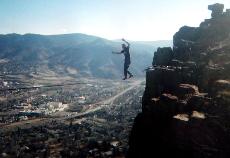David Shelley and Robbie Shields, both 19, might be the most “extreme” guys at DVC.
For the past three summers, they have spent a month in the Yosemite Valley, hanging out, rock climbing, and “highlining,” an increasingly popular sport that attracts the same crowd as rock climbing.
High-liners walk on a 1-inch nylon strap over huge gaps between cliffs, hundreds of feet in the air, with only a short “leash” to catch them when they fall.
“It’s about 1,100 feet above the valley floor,” says Shields of one spot he’s crossed in Yosemite.
“Half of your body is saying you shouldn’t do this, and the other half is determined,” Shelley says. “When you’re out there, you have to keep focused.”
“Your foot that’s still on the rock, feels like it’s glued,” Shields says about taking that first step out, “You’re in the zone.
“It’s one of the coolest feelings ever. Like a meditative focus.”
Shelley and Shields first got into the activity during high school.
“My buddies got me into it,” Shelley says.
“I started slack-lining probably my freshman year and highlining my junior year,” Shields says.
Someone had set up a slackline (a much lower version of the high-line) between two trees in a undeveloped area across the street from Campolindo High School, and they practiced crossing the line.
Since then, the two friends have stepped it up considerably.
Now, they go out with ropes, harnesses, bolts, and straps. And they’ve learned the proper knots and how to secure a line to a rock slab.
“It’s pretty complicated,” Shelley says of the learning curve. “Just by being out there every day, eventually you just get it down.”
Shelley also started rock climbing.
“I had to learn to climb to get to spots to do high-lining,” he explains in his laid-back way.
Climbers are a community apart from the thousands of tourists who throng Yosemite Valley in the summer. Shelley and Shields met people from all over the world who had come to test their skills against the Sierra granite.
“You get people up there who don’t speak English,” Shelley says about encountering such a climber while traversing a rock face. “It’s fun to try to communicate.”
Sometimes they scored free food from other young people they befriended who worked in the valley’s restaurants and cafeterias.
Despite how terrifying highlining seems to most people, Shelley insists it is very safe. The ropes and bolts are rated to hold thousands of pounds. There is a 6-foot leash attached to the line.
And they use two lines, one with more slack, should the main line break.
Wind and sun are two variables that affect balance. Strong gusts can blow the high-liner off, while late-afternoon sun can be blinding.
“The other end of the line is your focus point,” Shelley says. “If you closed your eyes or looked away, you’d probably lose your balance.”
Shields says some days he can hit the line perfectly and even walk backwards with no problems. Other days he can’t make it across.
“It depends on the line, and [my] state of mind.”
The two also do smaller trips throughout the year and are planning a return trip to Joshua Tree this winter. They also go high-lining locally every couple of months.
But Shields refuses to give up any of his local spots, some are not entirely legal.
Any big gap or space between two cliffs is good, he says.







































































